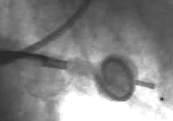
Mitral stenosis is a disabling and eventually lethal disease. If untreated, significant symptoms (eg, dyspnea and fatigue) and serious complications (eg, pulmonary edema, systemic arterial embolism, and pulmonary hypertension) occur. Medical therapy can relieve symptoms but do not affect the obstruction to flow. Surgical commissurotomy and open valvuloplasty were, for many years, the only methods by which mitral stenosis could be corrected, However, the development of percutaneous balloon valvuloplasty has revolutionized the treatment of this disorder and largely replaced surgery for mitral stenosis. A balloon is advanced from the venous circulation to the right atrium, across the interatrial septum to the left atrium, and across the stenotic mitral valve. Inflation and rapid deflation of the balloon opens the stenotic valve.
